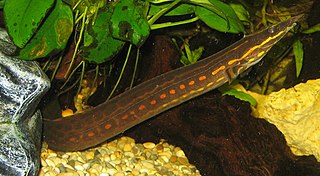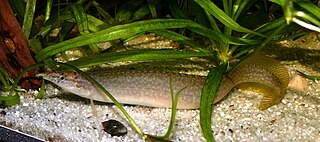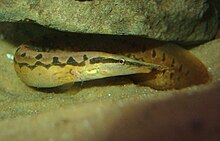
Synbranchiformes, often called swamp eels, is an order of ray-finned fishes that are eel-like but have spiny rays, indicating that they belong to the superorder Acanthopterygii.

The clown triggerfish, also known as the bigspotted triggerfish, is a demersal marine fish belonging to the family Balistidae, or commonly called triggerfish.

Cirrhitidae, the hawkfishes, are a family of marine perciform ray-finned fishes found in tropical seas and which are associated with coral reefs.
The Mastacembelidae are a family of fishes, known as the spiny eels. The Mastacembelids are part of the Order Synbranchiformes, the swamp eels, which are part of the Actinopterygii.
The name spiny eel is used to describe members of two different families of fish: the freshwater Mastacembelidae of Asia and Africa, and the marine Notacanthidae. Both are so-named because of their eel-like shape and sturdy fin spines. These two families are not related: the Notacanthiformes belong to the Superorder Elopomorpha, whose members are characterized by having leptocephalus larvae. The freshwater Mastacembelids do not share this characteristic and are popular specimens in the aquarium trade.

Enoplosus armatus, commonly referred to as the old wife, is a species of perciform fish endemic to the temperate coastal waters of Australia. It is the only modern species in the family Enoplosidae.
Mastacembelus is a genus of many species of spiny eel fish from the family Mastacembelidae. They are native to Africa and Asia. Most are found in rivers and associated systems, but there are also species in other freshwater habitats and a particularly rich radiation is found in the Lake Tanganyika basin with 15 species. A few species can even occur in brackish water.

The fire eel is a relatively large species of spiny eel. This omnivorous freshwater fish is native to in Southeast Asia but also found in the aquarium trade. Although it has declined locally because of this trade and overfishing for food, it remains common overall.
The lesser spiny eel, Macrognathus aculeatus, is a Southeast Asian tropical freshwater fish belonging to the family Mastacembelidae. They are uncommonly found in aquaria.
Macrognathus is a genus of eel-like fish of the family Mastacembelidae of the order Synbranchiformes.

The snakeskin gourami is a species of gourami native to Southeast Asia. Prior to the merging of Belontidae to the family Osphronemidae, the snakeskin gourami was regarded as the largest member of its family. It is still the largest species in its genus and subfamily.

Mastacembelus platysoma is a species of fish, a spiny eel in the family Mastacembelidae. It is found in Lake Tanganyika which is bordered by Burundi, the Democratic Republic of the Congo, Tanzania and Zambia. The IUCN has listed it as being of "Least Concern".

The Peacock Eel or Spotfin Spiny Eel is a spiny eel found in freshwater habitats throughout Southeast Asia. They are commercially important as food and aquarium fish.

Myrichthys maculosus, commonly known as the tiger snake eel, the ocellate snake eel or the spotted snake eel, is a species of fish in the family Ophichthidae, native to the Indo-Pacific. It is occasionally encountered in the aquarium trade. It grows to a length of 1 m (40 in).

Mastacembelus ellipsifer is a species of spiny eel that is endemic to Lake Tanganyika in Africa and sometimes kept in aquariums. Although sometimes called the Tanganyikan spiny eel, it is only one of fifteen spiny eel species in the Tanganyikan basin.
The kuhli loach is a small eel-like freshwater fish belonging to the loach family (Cobitidae). They originate from Indonesia and the Malay Peninsula. This snake-like creature is very slender and nocturnal. In an aquarium, the kuhli loach can be very reclusive and, when startled, will dart underneath tank ornaments or bury itself, if a fine gravel or sandy substrate is present.
Macrognathus pentophthalmos, the Sri Lanka five-eyed spiny eel, is a small species of spiny eel that is endemic to freshwater habitats in Sri Lanka. Described as a common species as recently as 1980, for unknown reasons its population rapidly declined in the following years and there are no recent confirmed records. In 2012, it was listed as "Critically Endangered, possibly Extinct" in the Sri Lankan National Red List.
Boulenger's spiny eel is a species of ray-finned fish endemic to India, Myanmar and Thailand, known from Sittaung River, Salween River and Manipur River and possibly Irrawaddy River. Inhabiting large rivers and tributaries, it is consumed by locals but is uncommon in the aquarium trade. It may be threatened by habitat loss for deforestation, dams and overfishing and is harmless to humans.
Macrognathus zebrinus, the zebra spiny eel, is a species of spiny eel endemic to Myanmar, specifically known from the Irrawaddy River, Sittaung River and Salween River and may also occur in Indonesia. It was originally described as Mastacembelus zebrinus before being moved to the genus Macrognathus in 1984 and 1986.

Macrognathus fasciatus is a species of spiny eel found in the Manimala River and first described in 2014. Macrognathus fasciatus differs from its relative species by the presence of 28–30 dorsal spines, 26–27 vertical lateral lines on the body, 8–9 whitish yellow round spots present in a row in between every two vertical lines and first dorsal spine originate at the level or a little behind the end of pectoral fin.














